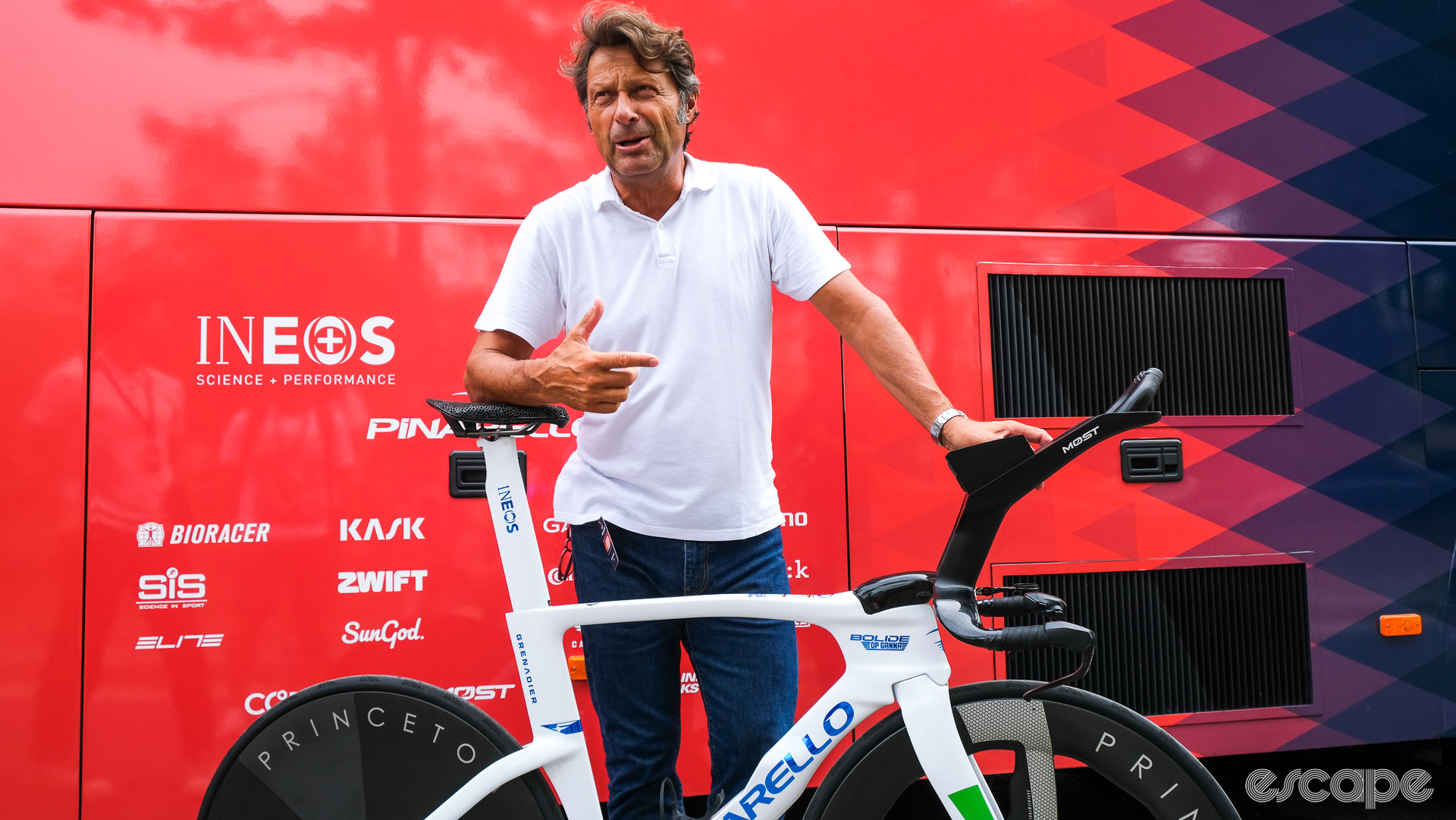We need more team time trials in this world. With such speed, synchronicity, and all the latest bike and aero tech, team-time trialling is as mind-boggling for spectators as it is painful for the riders. But with all the added jeopardy for a team’s overall chances, the event that proves so entertaining for us fans can be the most stressful for teams.
With so much at stake, not to mention the professionalism of modern cycling teams and their ever-increasing attention to every minute detail, teams take TTT prep very seriously. As far back as 2014, I’d watched in awe as Quickstep and Specialised staff stuck anemometers and sensors to hire cars before I took them on a recon around the TTT course the Giro would tackle a little over a month later in the Belfast Grande Partenza. The attention to detail was immense, right down to having me scale an eight-foot-high gate to government buildings with sensors in hand to ensure the course data was accurate while the car took a detour.
Given that was almost a decade ago, I was keen to closely examine how teams prepare and optimise for a TTT in 2023. That closer look came from an unlikely source. The Ineos Grenadiers (and Team Sky before that) are the original marginal gainers but also notoriously protective of their competition advantages. But, where there’s a will, there’s a way, and the team’s bike sponsor, Pinarello, wanted to use the Vuelta TTT to celebrate the long-term partnership between the team and manufacturer. Invite acquired, I had my literal “in.”
Only FDJ and Lappierre have a longer-standing partnership, with the Sky/Ineos/Pinarello agreement yielding 12 Grand Tour wins across 14 seasons built on uphill lead-out trains and time trial domination.
But those successes are on the decline. Eight grand tours have passed since Egan Bernal’s triumphant 2021 Giro d’Italia, and the once-dominant team have mostly played second fiddle to the new powerhouses in professional cycling, Jumbo-Visma and UAE-Team Emirates. True, the team has found success in other areas, winning multiple mountain bike and cyclocross world championships and twice breaking the World Hour Record in that time (three if you count Bradley Wiggins’), not to mention a monument and countless grand tour stage wins along the way.
Despite that decline, the team has a reputation for being at the forefront of technical innovation and performance engineering, and nowhere is that more obvious than in a team-time trial. I went along to the team time trial to see how the once-dominant superpower is optimising for the most optimised event in 2023 and look for clues as to whether the team can return to its dominant ways.
Nothing to see here?
Let’s start with what we didn’t see, and several days before the team time trial. With such a technical course for the TTT, it’ll come as no surprise that Ineos had identified riders knowing the course as key to a successful performance. What might come as a surprise is how they got to know said course. The city centre course was clearly not an option amidst the busy Barcelona traffic, so instead, Ineos hired the nearby Circuit D’Catalunya motor racing track and recreated as much of the Barcelona street course as possible.
The team used traffic cones to effectively recreate the corners of the Barcelona street course on the Catalunya circuit using Google Earth and VeloViewer to measure and plot corner lengths and severity.
Ineos Performance Engineer Dan Bigham explained the team not only wanted to practice corners and turn lengths, but also recreate the entire TTT process, including warm-ups, pre-cooling strategies, radio comms, puncture/mechanical protocols, and the like to ensure the act of team time trialling as fast as possible was as automatic as possible for the riders come what may on race day.
Best laid plans
Of course, we all know by now what did come on race day. Torrential rain on city centre streets that hadn’t seen rain in six weeks, plus nighttime racing without street lights. A team time-trialling disaster was almost inevitable, and so it proved with Ineos losing Laurens de Plus to an early crash and several other riders and teams coming down on the treacherous roads.
Conversely, the weather had been perfect, dry and not overly hot, until moments before the start. Ineos, like every other team, had no idea how bad conditions would get, and as such, their race day preparation plans were unchanged.


Those race day plans, as you might expect, featured a course recon. As I loitered around the Ineos paddock, it was almost immediately obvious how different Ineos’s recon plans were compared to every other team I had seen.
TTT day is one of the longest for team staff, only beaten to that accolade by an individual time trial stage. Every team has its staff and vehicles on site hours before the recon even starts. Where Ineos differed, though, was that the team had its riders show up at least an hour, perhaps two, before any other team. Why so early? Ineos conducted what I can only describe as an “advanced recon,” which not only involved riding an additional lap of the course to what I saw many teams do, but also included a pre-recon warm-up routine on stationary trainers, just like they would do before the actual race.
Why warm up for a recon, I hear you ask? According to Bigham, the team mostly wanted to “get the legs moving” so that the second they were on course, they were comfortable and limbered up ready to fully focus on the actual recon. Anyone who has ever done an interval or turbo trainer session will probably know how the first few minutes of a ride differ from later in the ride when you’ve completed a warm-up and are ready to do the work scheduled for that day.
The pre-recon warm-up also offered the team a dress rehearsal of their pre-race plan. As per usual, Ineos had trainers and fans set up for each rider to warm up and keep cool with. What was new, though, was what I can only describe as the “chill tent.” Rather than warm up directly outside the team bus in the uncontrollable (and forecast to be hot) ambient conditions, the team had a gazebo with walls for an almost entirely sealed cool room.
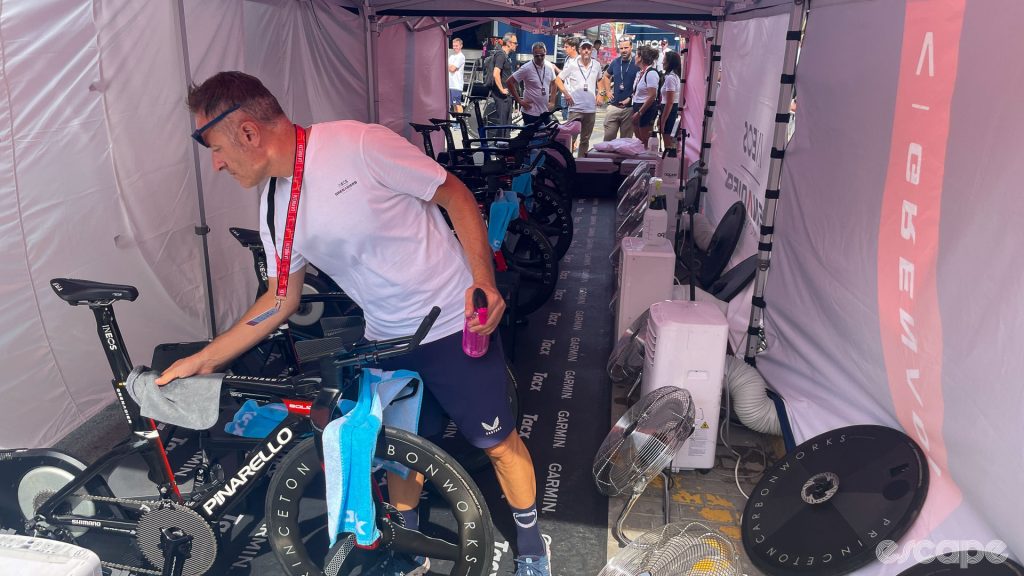
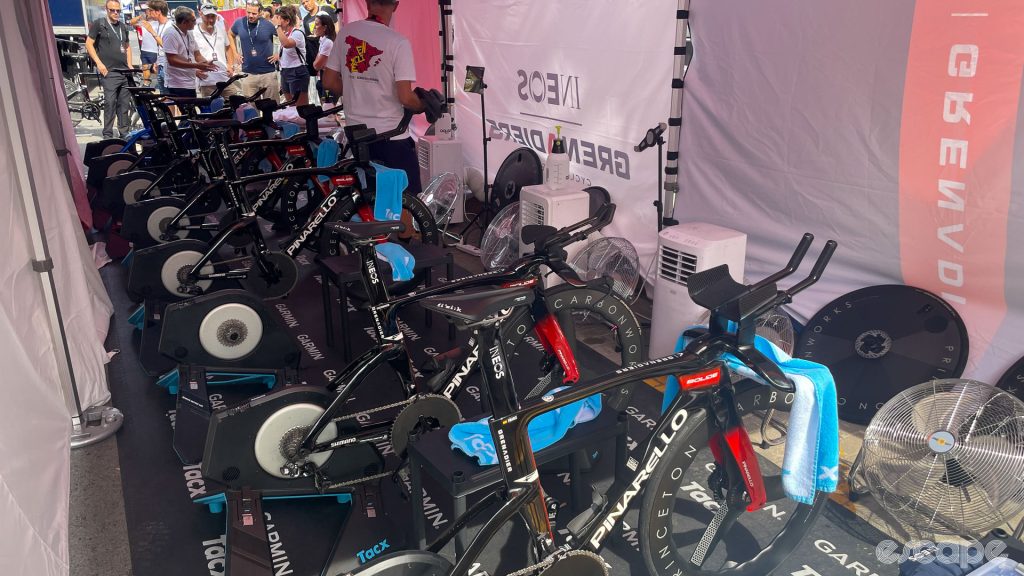
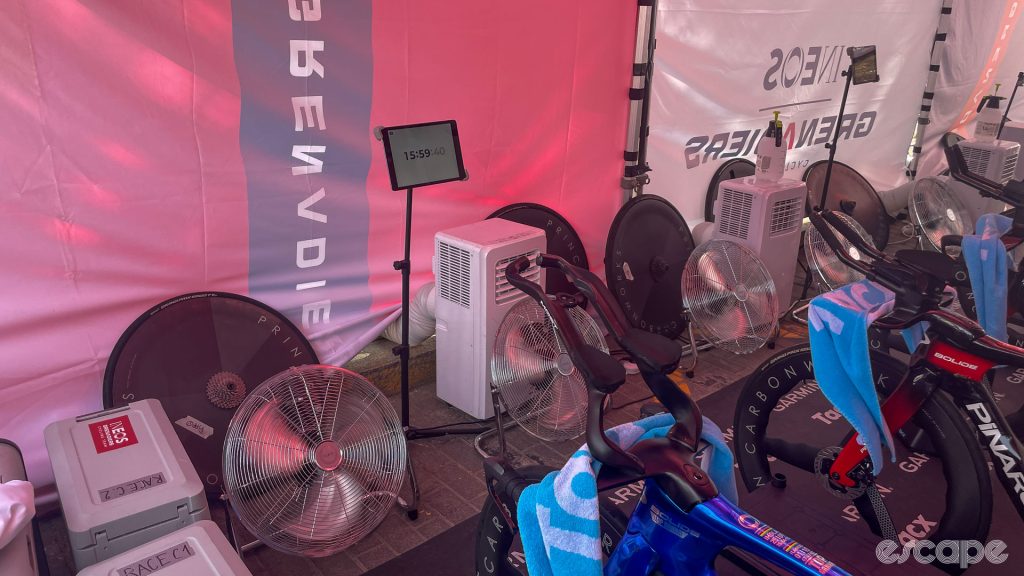
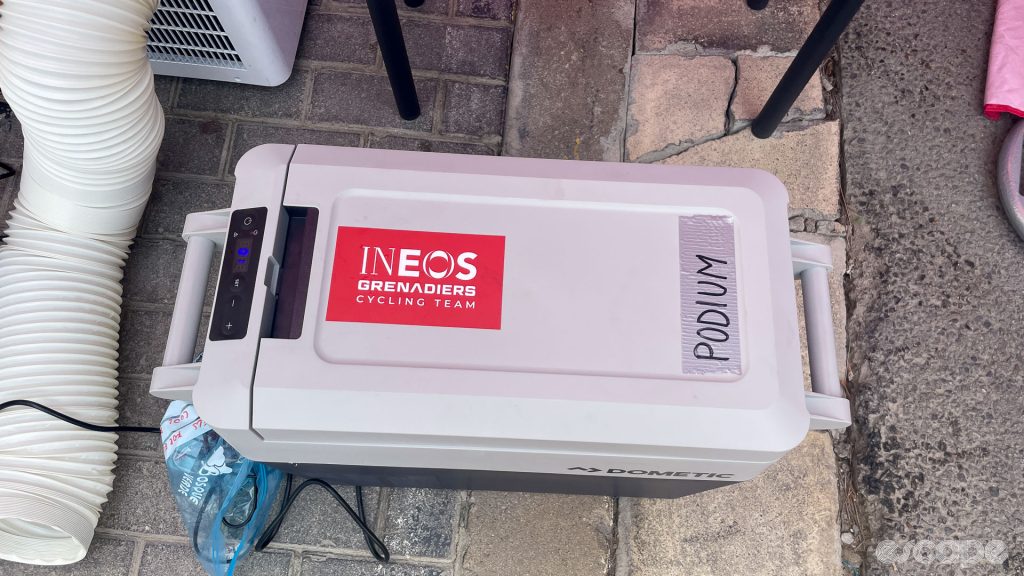
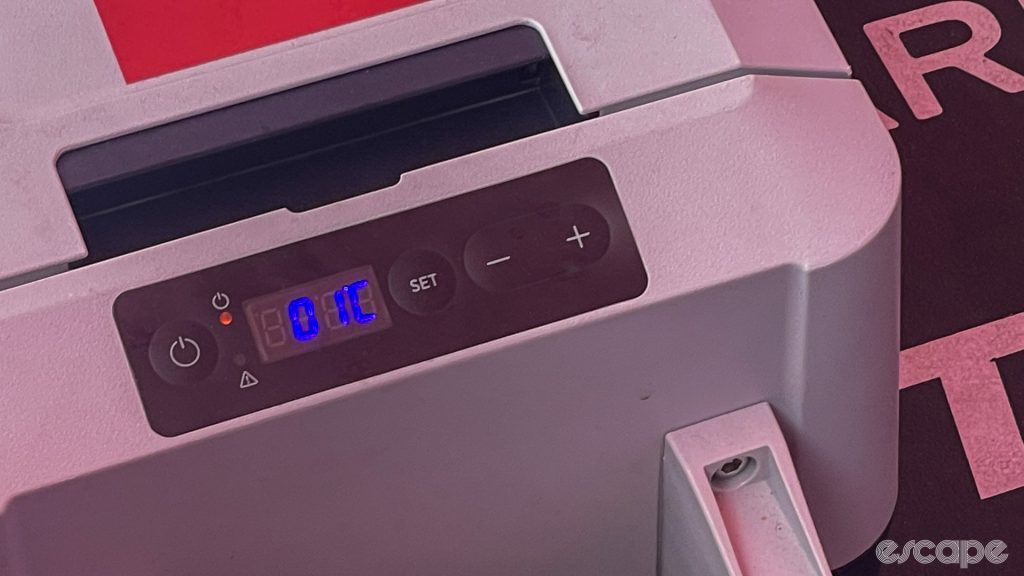
Each rider had their bike on a trainer within the cool tent with a fan and portable air conditioner unit each. Ineos were not the only team with such a setup, though, as Bahrain-Victorious had a similar tent complete with air conditioners, fans, and ice. I also spotted Dometic ice chest powered insulation boxes within the Ineos tents with built-in temperature displays fluctuating between 0° and 1° Celsius (32-33.8F).
As discussed several times already, pretty much every team is now aware of the benefits of pre-cooling and maintaining thermo-regulation. Teams are now acutely aware of how catastrophic overheating is in terms of performance and so will go to great lengths to ensure their riders keep cool. To this point, presumably, it was ice slushies in those cooler boxes given the “phase change” (melting ice) benefits of ingesting ice to maintain a cooler core temperature the team identified during its preparations for its successful Hour Record attempts. I do wonder, though, given Ineos’s budget, why the team doesn’t just go the whole way and bring a refrigerated rigid truck to the races and have the riders warm up inside where the dairy products once sat.
Pre-recon warm-ups complete, the riders did two laps of the technical Barcelona circuit. As it happened, with the weather closing in before the actual race, the second of these recon laps turned out to be their fastest of the day, despite not pushing full race pace or even wearing their aero kits for the most part.
The fact the team rode at speed surprised me a little. I had thought they would want to take their time and assess each corner. However, as Bigham explained, the team wanted to get a feel for the circuit’s many corners, the racing lines, turn lengths, and turn change locations at race speeds. Riding at close to race speed allowed the team to better understand timing between turns and make notes of fixed points whereby a rider must make their change off the front before in order to have time to get on the rear of the train before the next corner or else maintain their position on the front through said corner.
Furthermore, the recon offered the team’s technical support staff a chance to correlate their performance models with representative ride data on the course, complete pace and corner notes for delivery over the radio during the event, and fine-tune tyre pressures or any remaining equipment choices.
Virtual Pit wall
As it turns out, these recon laps were anything but representative, given how wet the streets turned later in the day, but nevertheless, the team’s process is fascinating. Particularly fascinating is something called the Virtual Pit Wall. Developed in partnership with Swiss Side, the team is extraordinarily tight-lipped about what exactly this performance modelling, strategy simulation, and online analysis tool is.
What we do know is the earliest version of the Swiss Side tool, first developed back in 2019, combines performance simulation, computational fluid dynamics (CFD), wind tunnel testing and on-bike aero rakes for real-world aero assessments. While the latest iteration, described as the “2nd gen,” is thought to include many more data points such as course technical details, including corner severity, to aid in calculations on non-standard courses where climbs, descents, and corners are typically more challenging for performance modelling software to accurately predict.
Again, remaining tightlipped, the team at the Vuelta wouldn’t be drawn on the complete capabilities of the V-Pit Wall, merely confirming the tool was used to assess each rider’s performance capabilities and aid with calculating optimal pacing, pull duration, and pull distribution for each rider on set courses. In fact, the team collects and analyses so much information it has a strict process to control how much is filtered through to the riders to avoid overloading them. This is especially the case during the stage where only the chief director sportive will talk with the riders through the radio, delivering only what they need to know and when they need to know it.
Perhaps the most interesting of what we do know is the V-Pit Wall’s ability to optimise turn lengths, turn distribution, and power targets for each rider. Some riders naturally have more of an influence on team performance than others, take Filippo Ganna, for example. The World Hour Record holder and two-time world-time trial champion is one of the key engines within the squad. As such, the team want to ensure he is on the front on long straight and power-critical sections of the course rather than wasting his pulls through corners when the squad is speed-limited anyway. We believe the pre-race analysis helps the team calculate the optimal starting order, pull duration, and change locations to ensure Ganna, and others, are on the front at the right time to maximise their effectiveness for the team.
The virtual pit wall is also capable of using data collected from on-bike aero meters and other devices, although the team confirmed no aero-meters were used during the Vuelta TTT recon.
Equipment
There is also all the preparation, R&D, and equipment testing that happens months and years in advance. If ever there was a showcase event for manufacturers in road cycling, it must surely be the TTT, a theory all but confirmed by Fausto Pinarello, who admitted the event is somewhat of a “competition between manufacturers” also.
In fact, for the man now at the head of Pinarello, developing a time trial bike is clearly a real passion but also essential in developing the brand’s entire range. “A time trial bike is really special, it must have the best aero, the best shape, and best weight, it’s more fun to design, but also you want to design the fastest bike possible. That then leads into the design of other bikes,” Fausto explained to Escape Collective.



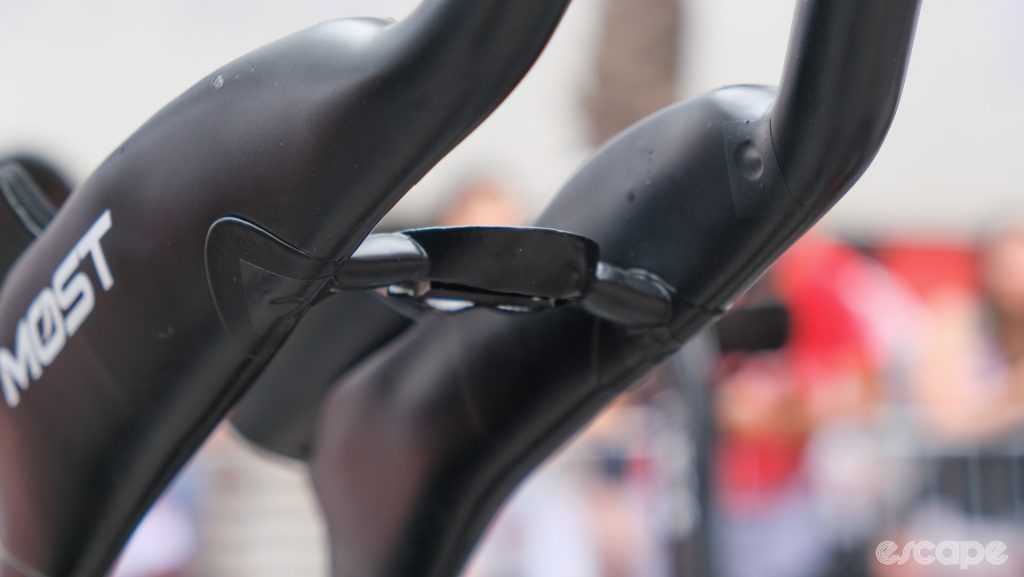
To be fair, Fauto’s words merely confirm what we already knew to be the case, as evidenced by Pinarello’s history in the TT and Hour Record space. Think Espada, Bolide, Bolide HR and the tech or design elements that originated on some of these bikes before eventually making their way onto road bikes. The fork aero tab first developed for Wiggin’s Bolide HR bike ended up on pretty much every Pinarello performance bike since then being one recent example.
We will have to see whether or not that trend continues with the new Bolide F time trial bike unveiled last year and whatever follows in the next iteration of the Dogma road bike, but in the meantime, one area Pinarello, MOST (Pinarello’s components brand), and Ineos are seemingly leading the way is in time trial extensions.
Custom and aero-profiled, even 3D-printed, time trial extensions are commonplace within the World Tour now, but the sheer number of variations Ineos takes is still pretty remarkable. Take Ganna, again, for example.
It is only around twelve months ago that the time trial specialist blew our minds with his wild-looking, almost kinked elbow-like, flow-controlling, wake-generating, call it what you will, one-piece risers and extensions. These highly complex and precise shapes were designed using CFD for what was theoretically the optimal shape for Ganna. It’s as F1 as it gets in our sport.
Fast forward to the Vuelta start, and despite all the R&D and presumably expense that went into those kinked elbow extensions, Ganna has an entirely new extension design which, on first impressions, seems a much-simplified version, but on closer inspection, clearly features no shortage of R&D work and aero tricks.
Simpler they may look, but the extensions are said to be even more aerodynamic for Ganna. They are the result of a development process between the team and Pinarello/MOST to not only create a faster complete time trial front-end system for every rider, but to do so in a much more efficient way that will ensure the team can develop the fastest setup for more riders, much quicker. That’s a crucial difference, because while Ganna’s “elbow riders” were mind-blowing for a barge board-loving F1 fan and time trial loon like myself, they were so expensive and time-consuming to develop, similar systems were inaccessible to most of the other riders on the team even with Ineos’ budget.

Future
Of course, as already mentioned, all that careful planning went out the window when the treacherous conditions resulted in an early crash for Laurens de Plus. Nevertheless, the team will no doubt have taken learnings from the Vuelta TTT. Perhaps we will see a support car covered in spot lights for the next late evening start team time trial or more development put into wet weather tyres. Interestingly, Evenepoel and Soudal-Quickstep seemingly opted not to use their new “Wet” tyres for this stage.
For all their attention to detail and preparation, though, Ineos can’t seem to convert all the marginal gains to Grand Tour success in the same way Jumbo and UAE currently do, or as Team Sky once did. Perhaps more worryingly, the team are seemingly losing key riders and staff hand over fist this silly season. Tao Geoghegan Hart is the most high-profile rider to leave, but many backroom staff are also moving on. If rumours are correct, an audacious bid to sign Remco Evenepoel seems to be the team’s answer to arrest the slump, but even that seems 50:50 at best. In a results-based industry, how long can the once all-conquering team’s Grand Tour drought last before the consequences bite? I was keen to understand if a drop off in Grand Tour success might influence the depths of Pinarello’s R&D or pro-only niche bikes budget.
We asked Fausto Pinarello if this perceived slump could risk the long-standing relationship between Pinarello and the team. Fausto’s response was simple, “It’s always better when you are winning, but the team is good.” Judging Pinarello’s chairman’s enthusiasm throughout the day about Hour Record bikes, hardtail and full suspension mountain bikes, and cyclocross bikes, winning the Tour de France is no longer the only means for measuring success.
That position seems reasonable given that despite the undeniable slump in Grand Tour success the team is still clearly among the forerunners in the marginal gains philosophy and development practices it pioneered in cycling. In fact, one gets the feeling from talking with Fausto that the team’s aforementioned R&D focus and relentless quest for the next marginal gain is actually what keeps him involved and thus will keep Pinarello involved so long as he still has the final say in everything the company does. Pinarello continually pointed to the business case, or lack thereof, for projects such as the 3D printed Hour Record frames at 60 grand a pop, the mountain bikes that “may” be available in the market from next April, and the cyclocross bike, which presumably isn’t all that lucrative to the brand, all as evidence of the performance-first approach it is taking to its partnership with the team. Of course, the rumoured 60 grand price tag for a track frame may be the team and brand exploiting a loophole in the UCI’s commercialisation rules, but nevertheless, it’s one of four bikes the brand developed in the past two years none of which are likely to have a positive impact on the bottom line of the company’s books.
Pinarello also acknowledged the importance of being partnered with a top team, explaining, “It might be OK to be out (of the World Tour) for a year or two, but more is a problem.” Before adding, “(being on the) Podium or winning is not so different,” in response to our questioning if not winning the Tour de France is a problem. As for whether the GC success slump affects what happens at the end of 2024 when the current deal between Pianrello and Ineos ends, Pinarello was even more emphatic: “We just continue. We work on Olympic cycles. Every four years, we renew.”
Then we posed the Remco question and got as direct an answer as you’ll ever get from anyone in the World Tour: “Who wouldn’t want Remco on their team? Which manufacturer wouldn’t want Remco on their bike? But he has a contract, so he will stay there.”

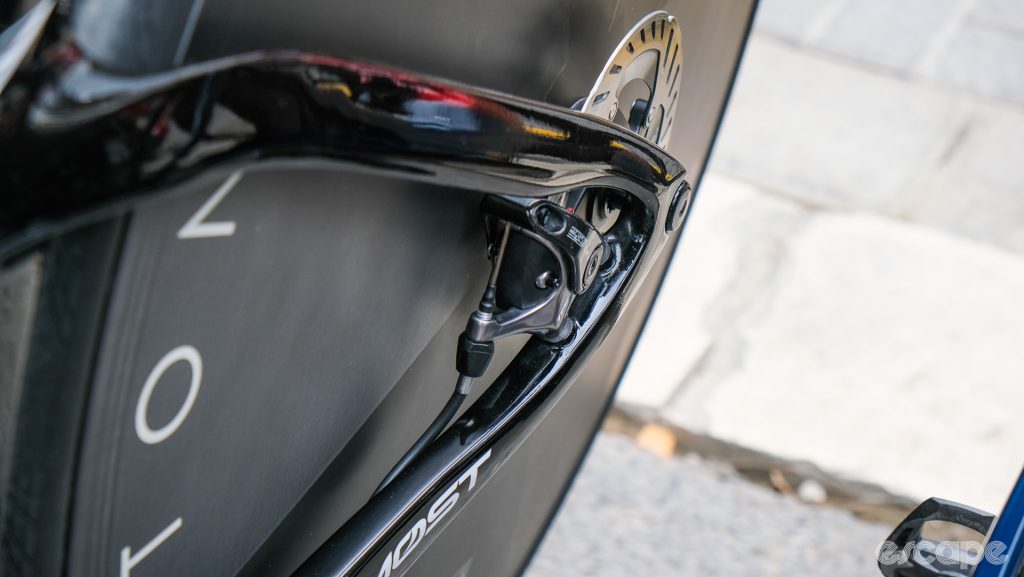

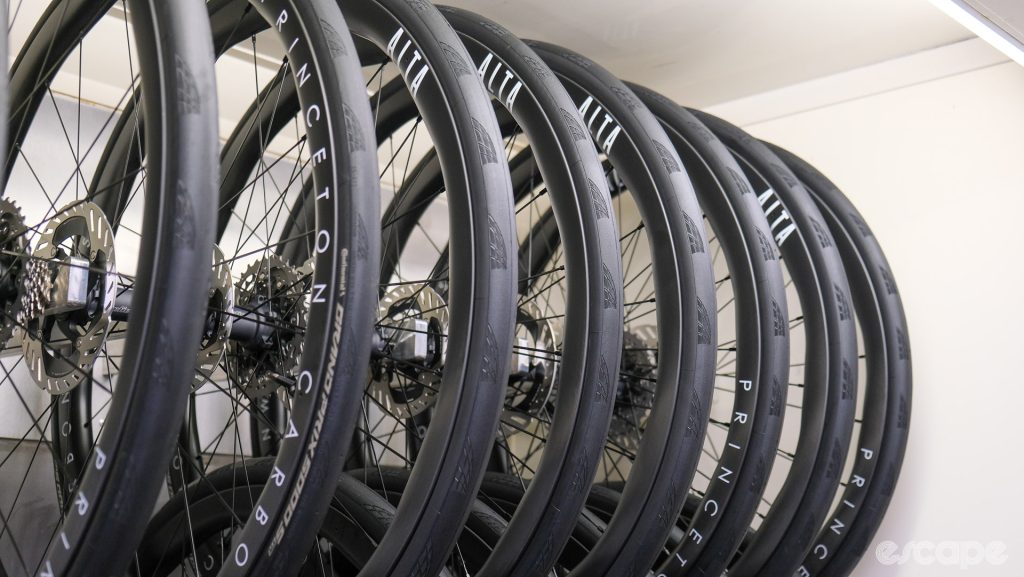
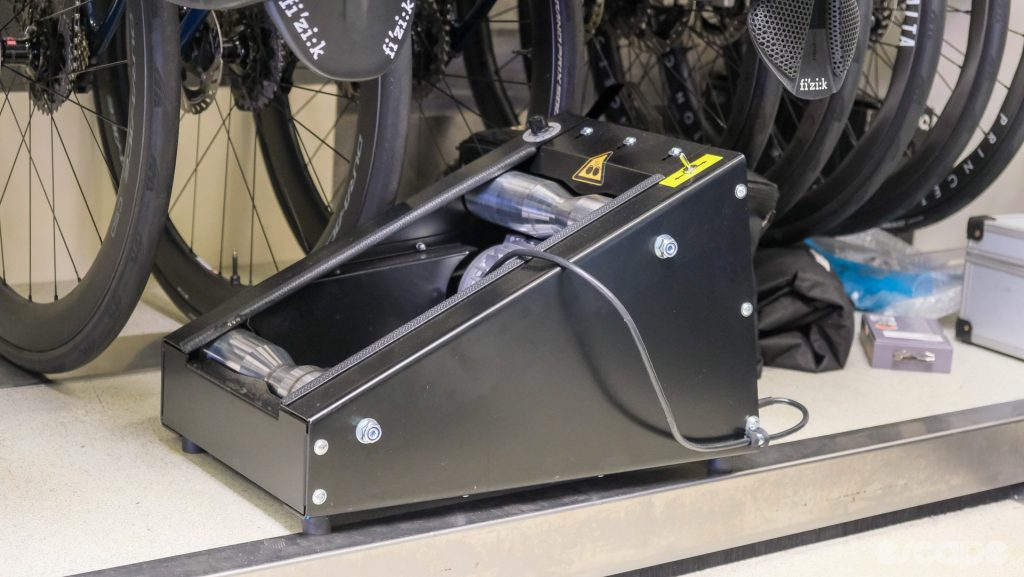
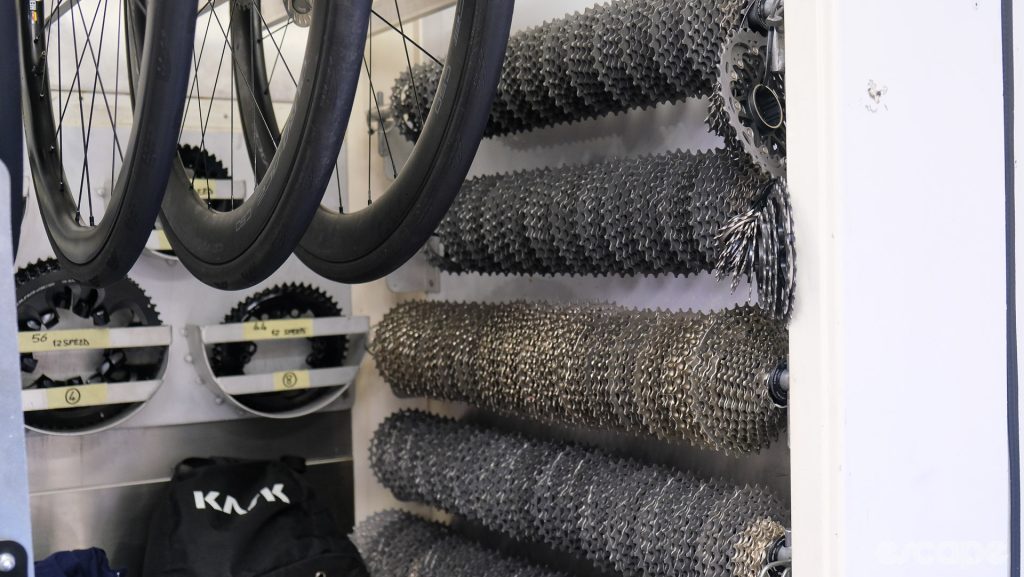

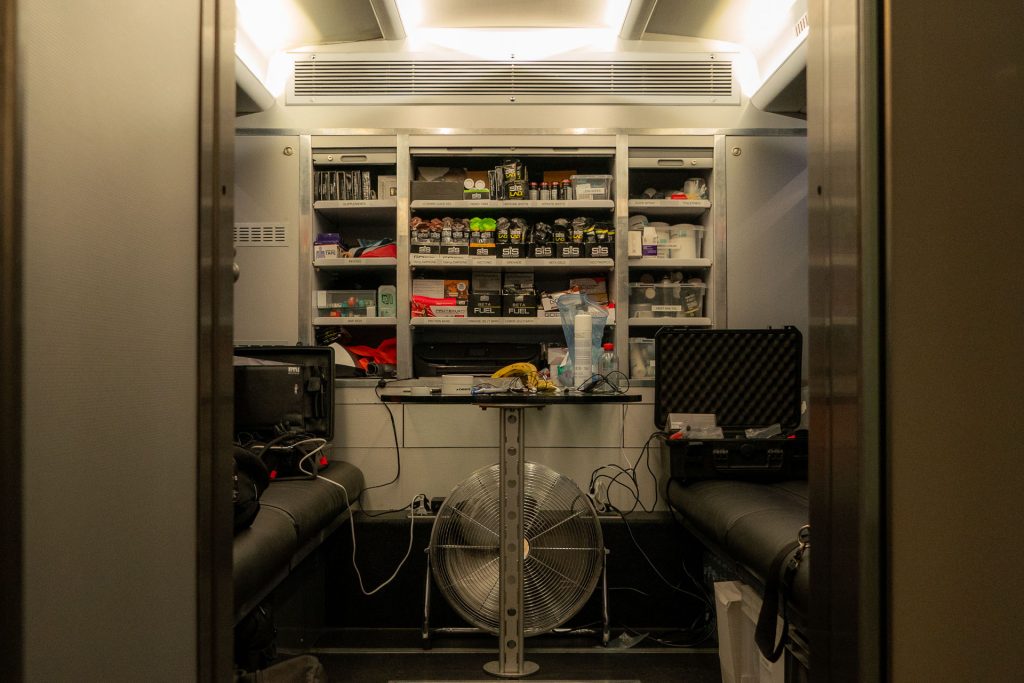

What did you think of this story?
